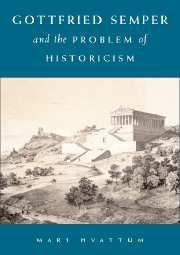Book contents
- Frontmatter
- Contents
- List of Figures
- Prolegomenon
- Introduction – Gottfried Semper: Texts and Interpretations
- PART I TOWARDS A POETICS OF ARCHITECTURE
- 1 The Cult of Origins
- 2 The Doctrine of Imitation
- 3 Semper and the Poetics of Architecture
- PART II PRACTICAL AESTHETICS
- PART III THE APORIAS OF HISTORICISM
- Epilogue
- Notes
- Selected Semper Bibliography
- Bibliography
- Index
3 - Semper and the Poetics of Architecture
from PART I - TOWARDS A POETICS OF ARCHITECTURE
Published online by Cambridge University Press: 06 August 2009
- Frontmatter
- Contents
- List of Figures
- Prolegomenon
- Introduction – Gottfried Semper: Texts and Interpretations
- PART I TOWARDS A POETICS OF ARCHITECTURE
- 1 The Cult of Origins
- 2 The Doctrine of Imitation
- 3 Semper and the Poetics of Architecture
- PART II PRACTICAL AESTHETICS
- PART III THE APORIAS OF HISTORICISM
- Epilogue
- Notes
- Selected Semper Bibliography
- Bibliography
- Index
Summary
The previous chapters outlined the way in which notions of origin and imitation conditioned architectural discourse in the late eighteenth and early nineteenth centuries. Semper was profoundly influenced by this discourse. He shared many of the prevailing neoclassical attitudes and framed his theoretical pursuits in terms of origins and imitation. He also had a thorough knowledge of idealist and romantic philosophy, and its influence on his work is convincingly documented. Yet, Semper subjected the notions of origins and imitation to a radical reformulation until they no longer had the same meaning as for his neoclassical or romantic predecessors.
THE PRIMITIVE HUT REBUILT
We have already encountered Semper's scornful attitude to enlightenment theories of the origin of architecture. In his opinion, the obsession with the primitive hut had produced merely “fruitless speculations, which have not seldom led to dangerous errors and false theories”. Semper dismissed the wooden hut as the formal origin of the Greek temple, and rejected Quatremère's ‘fairy tale’ of the cave and the tent. Although recognising its importance, he refused to frame the question of origins as a search for the original abode of man, concluding categorically that “it is impossible to trace architecture, as the expression and accommodation of social organisms, back to its earliest beginning”. To attempt such a thing would be like wanting to trace a language back to “the babbling of children or to the unarticulated voices of the animal world”.
- Type
- Chapter
- Information
- Gottfried Semper and the Problem of Historicism , pp. 64 - 84Publisher: Cambridge University PressPrint publication year: 2004



